Rainbow Jam |
Personnel: Richard Taylor The best Light Show in the world..??........Well that’s what Jerry Garcia said, and he’d seen a few in his time...
When I finished art school I had a variety of zinc and copper plate scraps left over from printmaking. I had been etching and engraving quite a lot in school. After graduation I was so broke I couldn't afford new plates so I began to develop processes for working on those small scraps. The scraps were 2 or 3 inches wide by 3 or 4 long. I would coat the plates with softground and draw through the dark ground revealing the copper or zinc underneath. I developed a kind of pointellistic technique using a steel needle in a drafting pencil lead holder. I couldn't work at that scale comfortably with unaided sight so I began looking for a way to magnify the work. I eventually hit on using a jewelers magnifying glass. It worked quite well. About the same time I found a delightful Queen Anne Cottage in the Avenues District in Salt Lake City. A friend of mine, Allen Covey ( the younger brother of Mikel Covey who later became my first Light Show partner) started a promotion company called Numenor. They started out with a ripping show featuring Buffalo Springfield, The Youngbloods and H.P. Lovecraft. I suppose that since I had the perfect counter culture pad and lived there alone, Allen asked me if I would host the five members of the Light Show. I can only remember some of their names. Jerry of course and his girlfriend Marilyn, Kathryn Hall, a guy named David, another guy and another chick (as we called them) who I can't recall. This was my first inside look at how Light Shows worked. Different members of the crew had different tasks during the performance. Kathryn helped Jerry with the liquids as did Marilyn. Jerry had been a pornographic filmaker and had a lot of 16MM footage from those days. They used Lietz projectors, behind large color wheels, that were hand fed in a more or less random fashion during performance while 16MM film loops were running and liquids were being projected. The artwork for the slide projectors were sort of democratically created by whomever. I think David did most of them. His technique was to cover a lietz glass slide cover with black acrylic. He would let it dry and place it on a little light table and scratch through the acrylic with a pointed instrument. He was a technician and had no art training so the slides were quite rough. They were used as decorative elements or as title slides. What struck me with perfect symmetry was how similar the process was to what I had been doing on the metal plate scraps. My techniques were the culmination of intense training in art school in the Modernist tradition that included basic drawing then intermediate drawing through advanced and then figure drawing. I had gone through a similar painting regime. I studied printmaking and art history, sculpture and design both 2d and 3d. So by the time I realized what lightshows were and how they were created I was loaded for bear as they say. As I observed the inner workings of Jerry's show I realized I was also seeing an elegant bridge into a new land of light and performance that I had been training for the past 6 years. When they left I immediately went down town to a photo shop on Main Street and bought a box of Lietz cover plates. I built a makeshift light table from a 9" by 14" pane of glass. I taped a piece of drawing film to the underside of the glass to diffuse the light and rigged a light bult under the glass and leaned it against some books. I taped the bottom edge of the glass to the table and began drawing on those miniature glass surfaces. That was an exciting moment in my creative oddysey. I had a new friend (Roy Blumenfeld) who I had also met through my work with Numenor. Roy was the drummer for the Blues Project and hung out in Salt lake whenever he passed through. One night he showed up with a small case and ceremoniosly opened it and presented me with my very first slide projector. It had belonged to his family and he thought I should have it. It was only one layer but rich with all kinds of newly discovered artifacts of the process and of light and it moved and the image broke into facets that slide across the primary image and suddenly I was playing visual music. Jerry Garcia thought that Rainbow Jam was the best Light Show in the world. The art work created on a large format then reduced in a process camera and pin registered onto slides. The effect was one of depth and visual sophistication played in real time with, for Light Shows, a new level of control. We also made animations from the same art work that was projected on 16MM motion projectors. These motion images were registered over the slide images. The overall effect was quite stunning. We created Rainbow Jam in Salt Lake City in the late sixties and took it to San Francisco in 1969 without contacts of any sort. The two of us, Richard Taylor and I, just drove down with the show and called the Family Dog from a phone booth next to the freeway in Berkeley. I called and asked for the booking agent. His name was Michael Christopher. I told him we were from Salt Lake City and had a Light Show that we wanted to show him. He said something to the effect of: You have a Light Show? and your from Salt Lake City? and you want to show it to us? Do you know how many Light Shows there are in the Bay Area? I said no. He said 150. And do you know how many of them are performing? I said no. He said 4 and the other 146 are waiting for their chance to audition and if I let a Light Show from Salt Lake City in the head of that line they would all hate me. So you see I can't really let you audition here at the dog before them. I hope you understand. We were obviously done with the conversation and I was about to thank him for his time and say good-bye when, as a kind of last second afterthought he said. I just took a show to Salt Lake City last month. It was Pogo (later changed to Poco) and A.B.Skye. Did you see that show? I said yes. Then he said: there was a poster done for that show that was one of the best rock posters of all time. You don't happen to know who did that poster do you? And I said yes, we did. He said, you did that poster and you have a Light Show? Ok, ok I'm changin' my mind here. How soon can you come over to audition? I said right now. He said ok we'll take a look at your Light Show. Less than two hours later, which is about how long it took to drive over and set it up and perform one piece, he and Chet Helms offered to manage Rainbow Jam and send us out on the road with their bands, one of which was The Grateful Dead. When Jerry first saw Rainbow jam he flipped. He immediately fell in love with it and we all became comrade artists out on the road. It was a magical time and I'll never forget it. I'm still tinkering with Light Show systems and carrying them to higher levels. Light Shows are still to me the one art form that never got recognised on the level that it should have. With luck and proper funding maybe someday that might change.
Kenvin Lyman aka "The Utah Kid", aka "Bon of Man"- November 2001 |
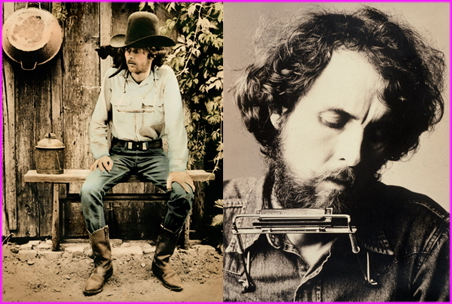 |
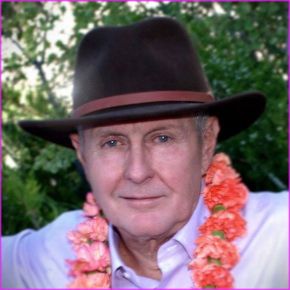 |
Transcript of an email chat with Kenvin (May 31st 2002) :Pooter, I thought you might enjoy reading Richard Taylor's, my partner in Rainbow Jam, interview detailing his and the Abel studios role in Star Trek the Movie. He talks about Rainbow Jam very briefly. He could never give it its full credit in an interview like this but in fact it had a profound effect on both of our careers. What he didn't talk about was that 'painting with light', as we called it, was more than a technique. It was where the look of 'Candy Apple Neon', as they called it, and the look of the legendary Seven-Up commercials came from. The first back-lit composite done with hi cons in layers with optical color and diffused halations recorded on Ektachrome was a piece I produced and shot on an old bed sheet stretched over a window screen frame in my dining room, on a 16MM Bolex, in Salt Lake called 'Tree of Life'. My studio, Dazzeland Studios drew heavily on Rainbow Jam too and its esthetic and techniques also systematically grew out of that show. Dazzeland Studios, in its own way, exploded onto the scene with a new look and process that was carried to the four corners of the planet on tens of millions of impressions in full page ads and editorial illustrations and coffee table books and dozens of other venues. Ahhh the roots of history back to a time we can never forget or ever give Kenvin. Heres the site for his interview (sadly the link has since gone offline):http://users2.ev1.net/~cinepixeldesign/Index/Trek/RTaylor.htm |
Transcript of an email chat with Kenvin (April 21st 2010) : |
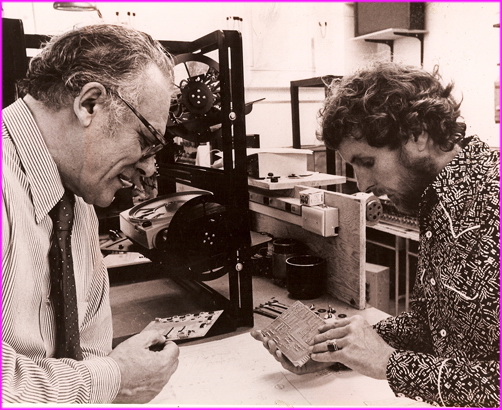 |
L - Vladimir Ussachevsky, R - Kenvin Lyman |
Hey you guys. Rainbow Jam went even further and when I have more time I will fill you in on that bit of history. I refer to it as "The Rainbow Jam Effect". In the photo I am sending Vladimir Ussachevsky is on the left and I, Kenvin Lyman, am on the right. Ussachevsky is considered by many to be the "Father of Electronic Music". He worked on RCA's first programmable synthesizer that was installed at Columbia University in the late Fifties. All the best from The Utah Kid.
|
What follows below are some articles that Kenvin sent me in May 2002. There were a number of external souces originally quoted but most have since gone offline. |
http://eyesofgaiainc.tripod.com/color.html http://www.greenspun.com/bboard/q-and-a-fetch-msg.tcl?msg_id=0001on We took a Light Show from, of all places, Salt Lake City to the Family Dog on the Great Highway in 1969. |
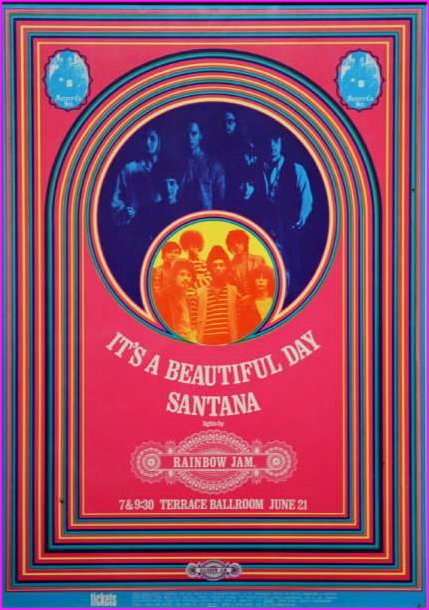 |
It's a Beautiful Day, Santana - Terrace Ballroom, Salt Lake City, Utah, June 21st 1969 |
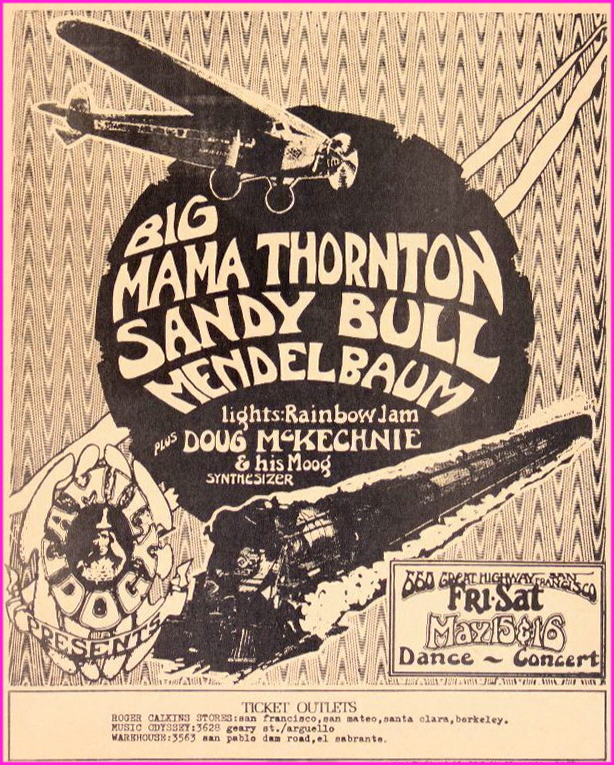 |
Big Mama Thorton, Sandy Bull, Mendelbaum - The Great Highway, May 1970 |
